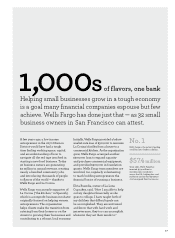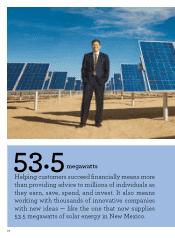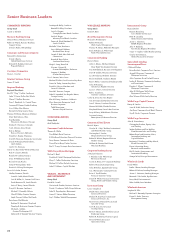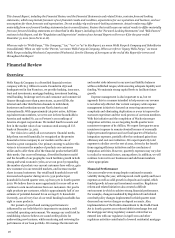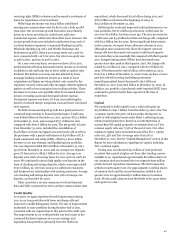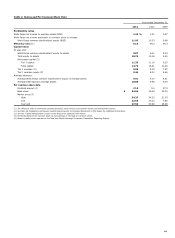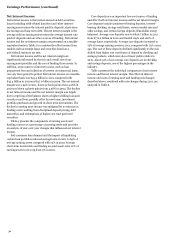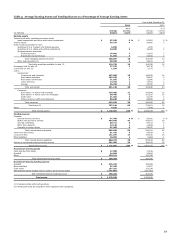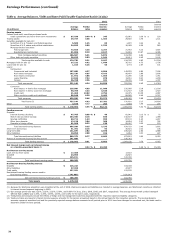Wells Fargo 2011 Annual Report Download - page 28
Download and view the complete annual report
Please find page 28 of the 2011 Wells Fargo annual report below. You can navigate through the pages in the report by either clicking on the pages listed below, or by using the keyword search tool below to find specific information within the annual report.
This Annual Report, including the Financial Review and the Financial Statements and related Notes, contains forward-looking
statements, which may include forecasts of our financial results and condition, expectations for our operations and business, and our
assumptions for those forecasts and expectations. Do not unduly rely on forward-looking statements. Actual results may differ
materially from our forward-looking statements due to several factors. Factors that could cause our actual results to differ materially
from our forward-looking statements are described in this Report, including in the “Forward-Looking Statements” and “Risk Factors”
sections in this Report, and the “Regulation and Supervision” section of our Annual Report on Form 10-K for the year ended
December 31, 2011 (2011 Form 10-K).
When we refer to “Wells Fargo,” “the Company,” “we,” “our” or “us” in this Report, we mean Wells Fargo & Company and Subsidiaries
(consolidated). When we refer to the “Parent,” we mean Wells Fargo & Company. When we refer to “legacy Wells Fargo,” we mean
Wells Fargo excluding Wachovia Corporation (Wachovia). See the Glossary of Acronyms at the end of this Report for terms used
throughout this Report.
Financial Review
Overview
Wells Fargo & Company is a diversified financial services
company with $1.3 trillion in assets. Founded in 1852 and
headquartered in San Francisco, we provide banking, insurance,
trust and investments, mortgage banking, investment banking,
retail banking, brokerage services and consumer and commercial
finance through more than 9,000 stores, 12,000 ATMs, the
internet and other distribution channels to individuals,
businesses and institutions across North America and
internationally. With approximately 264,000 active, full-time
equivalent team members, we serve one in three households in
America and ranked No. 23 on Fortune’s 2011 rankings of
America’s largest corporations. We ranked fourth in assets and
first in the market value of our common stock among all U.S.
banks at December 31, 2011.
Our vision is to satisfy all our customers’ financial needs,
help them succeed financially, be recognized as the premier
financial services company in our markets and be one of
America’s great companies. Our primary strategy to achieve this
vision is to increase the number of products our customers
utilize and to offer them all of the financial products that fulfill
their needs. Our cross-sell strategy, diversified business model
and the breadth of our geographic reach facilitate growth in both
strong and weak economic cycles, as we can grow by expanding
the number of products our current customers have with us, gain
new customers in our extended markets, and increase market
share in many businesses. Our retail bank household cross-sell
increased each quarter during 2011 to 5.92 products per
household in fourth quarter 2011, up from 5.70 in fourth quarter
2010. We believe there is more opportunity for cross-sell as we
continue to earn more business from our customers. Our goal is
eight products per customer, which is approximately half of our
estimate of potential demand for an average U.S. household.
Currently, one of every four of our retail banking households has
eight or more products.
Our pursuit of growth and earnings performance is
influenced by our belief that it is important to maintain a well
controlled operating environment. We manage our credit risk by
establishing what we believe are sound credit policies for
underwriting new business, while monitoring and reviewing the
performance of our loan portfolio. We manage the interest rate
and market risks inherent in our asset and liability balances
within established ranges, while ensuring adequate liquidity and
funding. We maintain strong capital levels to facilitate future
growth.
Expense management is also important to us, but we
approach this in a manner intended to help ensure our revenue
is not adversely affected. Our current company-wide expense
management initiative is focused on removing unnecessary
complexity and eliminating duplication as a way to improve the
customer experience and the work process of our team members.
With this initiative and the completion of Wachovia merger
integration activities, we are targeting fourth quarter 2012
noninterest expense of $11 billion. We expect first quarter 2012
noninterest expense to remain elevated because of seasonally
higher personnel expenses and our final quarter of Wachovia
integration expenses, partially offset by continued gains from
efficiency and cost save initiatives. We expect quarterly total
expenses to decline over the rest of 2012, driven by the benefit
from ongoing efficiency initiatives and the conclusion of
integration activities. However, quarterly expenses may vary due
to cyclical or seasonal factors, among others. In addition, we will
continue to invest in our businesses and add team members
where appropriate.
Financial Performance
Our 2011 results were strong despite continued economic
volatility during the year, with improved credit quality and lower
expenses as well as solid growth in deposits and capital, which
funded growth in loans and investment securities. Regulatory
reform and related initiatives also created a difficult
environment in which to achieve strong financial performance.
For example, changes mandated by Regulation E and related
overdraft policy changes implemented in third quarter 2010
decreased our service charges on deposit accounts. Also,
implementation of the Durbin Amendment to the Dodd-Frank
Act in fourth quarter 2011 reduced debit interchange fees and
the mortgage servicing regulatory consent orders that we
entered into with our regulators in April 2011 and other
regulatory activities contributed to lowered residential mortgage
26



